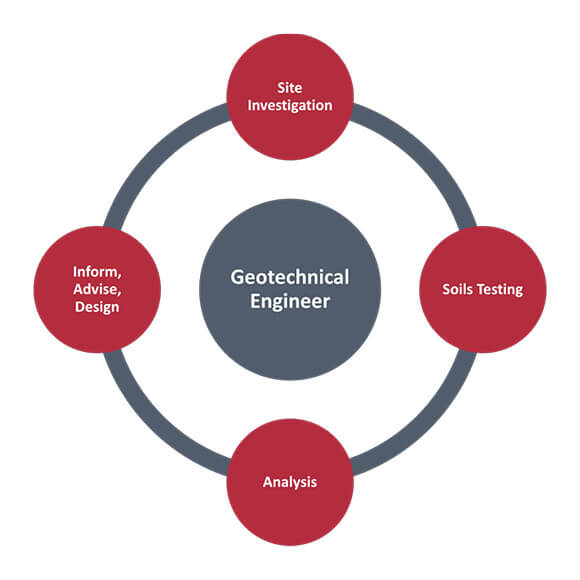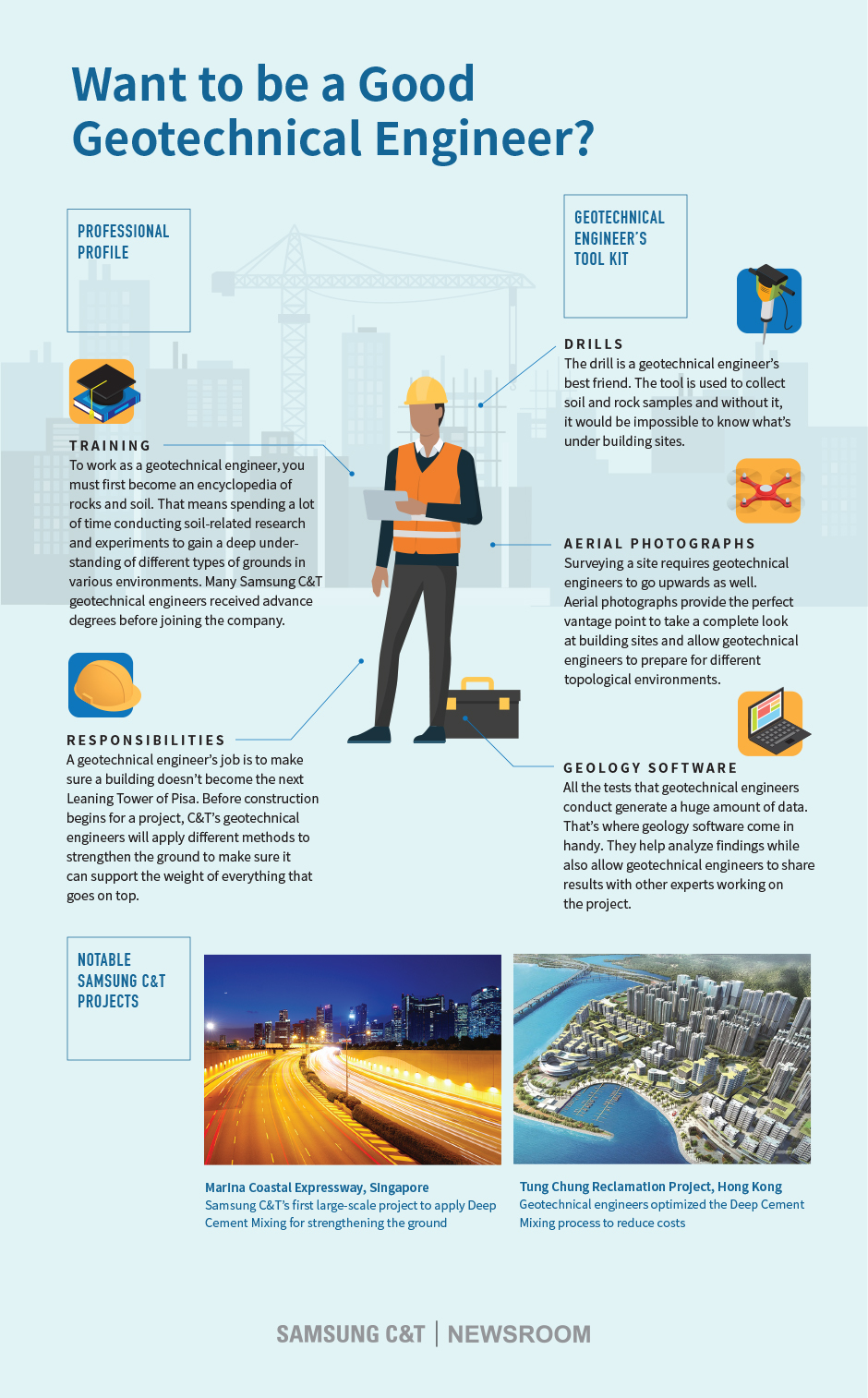7 Simple Techniques For Geotechnical Engineering For Construction Projects
7 Simple Techniques For Geotechnical Engineering For Construction Projects
Blog Article
Everything about Geotechnical Engineering For Construction Projects
Table of ContentsEverything about Geotechnical Engineering For Construction ProjectsAll about Geotechnical Engineering For Construction ProjectsIndicators on Geotechnical Engineering For Construction Projects You Should KnowSome Known Questions About Geotechnical Engineering For Construction Projects.The Basic Principles Of Geotechnical Engineering For Construction Projects Geotechnical Engineering For Construction Projects Things To Know Before You BuyWhat Does Geotechnical Engineering For Construction Projects Do?
Concepts and Practice of Ground Enhancement. Ground Improvement Concepts And Applications In Asia. Design evaluation in rock auto mechanics.Cengage Understanding, Stamford, 666 p. Atkinson, J., 2007. The mechanics of soils and foundations. The Observational Technique in ground engineering principles and applications.
Geotechnical Engineering For Construction Projects Fundamentals Explained
Lab and field screening plays an important role in this process. By drawing out examples from the planet's subsurface and using a collection of examinations, geotechnical designers can anticipate the behaviour of dirt layers and evaluate their suitability for various building and construction endeavours. The significance of geotechnical design in civil engineering can not be overemphasized, attributable to several aspects: The preliminary action in any kind of geotechnical research study includes figuring out the dirt kind at the construction site.
Understanding these attributes makes sure that only appropriate soil kinds are selected for the advancement, thereby averting potential structural failings. The structure functions as the bedrock of any type of building task. Picking the proper structure type is a decision that rests on the thorough analysis provided by geotechnical engineering. This makes certain the durability and security of frameworks by accommodating the tons they will certainly birth.

Geotechnical website examination is a crucial step in the planning and execution of any kind of building job. It involves the collection and analysis of information associated to the physical residential properties of dirt and rock below a recommended construction website. This details is vital for the style and construction of safe, secure, and sustainable structures.
A Biased View of Geotechnical Engineering For Construction Projects
, likewise known as subsurface exploration, includes a series of tasks intended at determining the dirt, rock, and groundwater problems at a building and construction website. The main purposes are to determine possible geotechnical threats, examine the engineering residential properties of subsurface materials, and offer suggestions for the style and building and construction of structures, keeping walls, and various other frameworks.
The workdesk study assists in recognizing prospective geotechnical concerns and intending the subsequent fieldwork. This involves observing the topography, drain patterns, existing frameworks, greenery, and any kind of indicators of instability or erosion.
3 Simple Techniques For Geotechnical Engineering For Construction Projects
Shallow test pits are dug deep into to directly observe and sample the dirt and rock. This approach is beneficial for studying the top layers of the subsurface and determining near-surface dangers. Non-invasive geophysical techniques, such as seismic refraction, ground-penetrating radar (GPR), and electrical resistivity tomography (ERT), are utilized to map subsurface conditions and spot anomalies.
Soil and rock samples accumulated throughout the field examination undergo research laboratory screening to establish their physical and mechanical properties. Usual lab tests include grain dimension analysis, Atterberg limitations, compaction examinations, triaxial shear tests, and debt consolidation tests. These tests give necessary information for geotechnical analysis and design. The information gathered from the workdesk study, site reconnaissance, field investigation, and lab testing are assessed and analyzed to establish a comprehensive Recommended Site understanding of the subsurface problems.
The main advantage of geotechnical site investigation is ensuring the security and security of structures. By comprehending the subsurface problems, engineers can develop structures and various other architectural aspects that can withstand the lots and environmental pressures they will undergo. This reduces the threat of settlement, subsidence, and architectural failure.
The Facts About Geotechnical Engineering For Construction Projects Uncovered
As an example, comprehending dirt features can lead the selection of excavation methods, dewatering approaches, and ground improvement steps. This makes certain efficient and secure building and construction techniques. Geotechnical site investigations are usually required by constructing codes and regulations. Following these demands ensures conformity with legal and security criteria, preventing prospective lawful responsibilities and task delays.
This info is very useful for project supervisors, engineers, and specialists in developing sensible schedules, spending plans, and contingency strategies. Geotechnical Engineering for Construction Projects. High-Rise Structure in a Coastal AreaIn a coastal city, try this web-site a skyscraper domestic structure was intended on a website with believed loose sand down payments and a high water table. A thorough geotechnical examination, including borehole exploration, CPT, and geophysical surveys, was performed
An Unbiased View of Geotechnical Engineering For Construction Projects
Based on these searchings check over here for, the structure design was customized to consist of deep stack foundations extending right into steady strata, and ground improvement techniques, such as vibro-compaction, were applied to mitigate liquefaction dangers. This proactive technique made certain the security and security of the building while avoiding expensive post-construction remediation. Facilities Growth on a Sloping TerrainA significant infrastructure task, involving the building and construction of a highway and bridges, was intended on a sloping terrain with high inclines.

The Leaning Tower of Pisa (Italy), a legendary building marvel, is notorious for its unintentional tilt from significant geotechnical concerns. The tower's structure was inadequately designed to handle the soft, unsteady soil underneath it, resulting in uneven settlement and its distinct lean. Our globe is populated with outstanding framework projectsfrom looming high-rise buildings to stretching bridgesall standing testament to the development of the various building and construction devices and approaches readily available.
Geotechnical design is a customized area within civil design that concentrates on researching the actions of planet products. This branch dives deep right into the groundinvestigating how the dirt, rock, and groundwater at a construction website can influenceand be influenced bythe facilities that we erect on and into them. Before a single brick is laid or a concrete structure put, geotechnical designers probe right into the earthgathering important information regarding the site's dirt structure, rock structure, and groundwater degrees.
The Best Strategy To Use For Geotechnical Engineering For Construction Projects

is a device utilized to analyze the integrity and load-bearing capability of heaps throughout installation, leveraging the concept of wave propagation. It maximizes construction performance by providing real-time examinations, therefore guaranteeing risk-free and effective pile foundations. One of the sensible applications of geotechnical design involves choosing and implementing the best techniques for structure building.
Load driving stands for more than the simple act of inserting architectural components into the ground. On the contrary, it is a very carefully coordinated process of moving a structure's load past the less stable dirt layers closer to the surfacedown to the more considerable strata that lie underneath. In the case of heap driving, take into consideration exactly how geotechnical engineers expertly use this method to evenly distribute the structure's weight.
Report this page